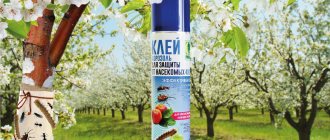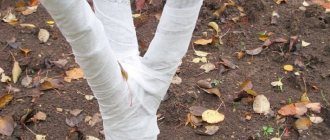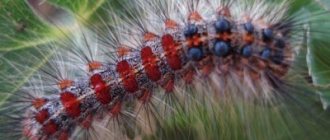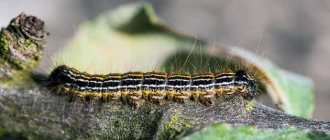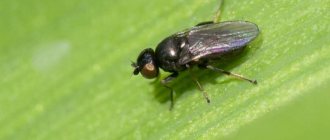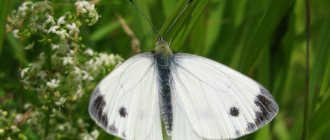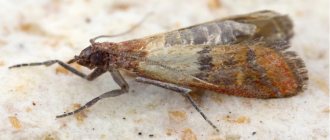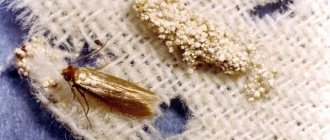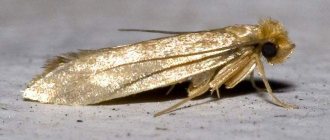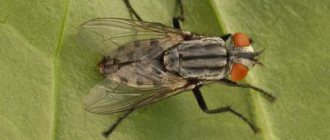Among the pests of fruit crops, the corrosive woody plant occupies not the last place. This is an insidious parasite that gnaws holes in the wood, thereby disrupting the sap flow of the plantings. As a result, the affected areas of the tree become so fragile that even a slight breeze can break them off.
The woodworm settles not only on fruit plants - it can be found both in the forest and in decorative plantings. If it is not stopped in time, it can not only cause significant damage to the crop, but also destroy the plants.
Life cycle of wood corrosive
Overwintered caterpillars begin to appear from May to September, when the average daily temperature reaches 10°C.
Females with heavy bodies rarely fly and lay eggs near the places where they emerged from pupae. The moths do not eat anything, live only a few days, and die soon after mating and laying eggs. Females lay 400 to 800 eggs individually or in small clusters in crevices in the bark. The larvae hatch after 10 days and begin to feed, often entering a nearby bud, twig or the crotch of a branch. They penetrate the core of small stems and large branches or trunks. The larvae move to larger branches when they become too large for those on which they feed. They grow up to 25 mm by the end of the first season. In autumn, the larvae make tunnels 50 mm or more below the surface of the bark, where they remain dormant during the winter.
The larvae resume feeding the following summer, survive the second winter in dormancy, and begin to pupate in the second spring after the eggs hatch. Pupation occurs in small chambers near the bark. After 4-6 weeks, the pupae emerge through the bark and partially emerge from the tunnels. The full life cycle takes 2 years.
Latest publications on Domorost
An LED strip that is impossible to pass by. New LED COB strip.
Chip on board (COB) technology has long taken a strong position in light sources such as LED lamps, spotlights, and LED modules. And so, not so long ago, I think about a year ago, it became available to wholesale customers...
Diary of a summer resident 2022.1 March.
I’m analyzing last year’s punctures. I planted very few peppers. This season I will try to restore the harvest of this vegetable. My pepper is growing well, and if we take into account that another greenhouse will appear, then we can “booze” and plant more. So…
Fence for the dacha, which one is better?
Hello everyone) I already know from experience that before you can blink an eye, it’s spring again, get back to work. In general, I have such a task on the horizon - to change the fence. Now there are so many different varieties. I have no idea what to choose. Or put...
Cats are counted in the fall: there will now be a cat counter in Moscow
A vacancy for a specialist in counting stray cats has opened up with the joint support of the capital’s Urban Animal Protection Fund and the Severtsov Institute of Ecology and Evolution of the Russian Academy of Sciences. In more detail, a volunteer is required who will...
The KinoDUEL festival will be held in Naukograd
The children's technology park "Naukograd" on the basis of the Moscow University of Finance and Law will host the open finals of the III International Educational Film Festival KinoDUEL from March 1 to 5. 55 countries are participating. Master classes, round…
The exhibition “Jurassic Ocean” will open on March 1
The opening will take place at VDNKh in the Moskvarium, during which until March 8 you can attend a scientific and entertainment festival on the 2nd floor of the Center for Oceanography and Marine Biology. From 11 a.m. to 6 p.m. daily there will be an interactive…
I'll try to save $2.37
The minimum wage in Kazakhstan is 42,500 tenge or $102 per month. You can spend no more than $3.4 per day. So I’ll try to save $2.37. And so Borodino bread, processed cheese and table water and you have almost exhausted the daily limit.
Symptoms and damage
The earliest symptoms appear as girdled or broken branches and branches with yellow, wilted foliage. The ends of the broken stems reveal larval tunnels in the tree and encircling burrows under the bark. Numerous, partially broken branches with dead brown foliage hanging in the tree canopy are characteristic of severe infestations. Symptoms on large branches and trunks are characterized primarily by small whitish fragments in crevices of the bark.
Later, a large amount of a fraction consisting mainly of small cylindrical yellowish or brown excrement pellets is released and can be observed in bark crevices and on the ground under the infested tree. The entrances to the tunnels are usually covered with silky fabrics.
In addition to burrowing under the bark, these insects build galleries up to 12 mm in diameter and 5 to 15 cm in length. The shape and size of these galleries vary greatly because the larvae repeatedly leave the galleries and create new ones, where they seriously damage infested trees. Large branches or even the trunks of small trees are sometimes encircled by such tunnels and sometimes break in the wind.
Ugly scars appear on the trunks of large trees as the bark dies, splits, curls and eventually breaks off. Injuries to trees lead to defects and the quality of lumber deteriorates.
Morphology
Imago. Large moth. Wingspan up to 70 mm. The head is white with a black forehead, the chest is white with three pairs of rounded spots, gradually tapering towards the rear edge of the dorsal part. The forewings are whitish with numerous angular purple-black spots along the veins. The hind wings are translucent, except for the anal region, with dense small purple-black spots. The abdomen is black, covered with white hair-like scales near the posterior edge of each segment. A flat brush of the same scales is also observed at the apex of the segment. Like all representatives of the genus Zeuzera, the corrosive tree has narrow wings with a noticeably beveled outer edge and a white back with six dark spots arranged in pairs.
Sexual dimorphism. Like all representatives of the genus Zeuzera, the males of the pest have antennae - double-combed in the basal half, serrated above. The combs of females are much shorter, and the apices of the antennae are simple. In addition, the male genitalia are well developed; the branches of the copulatory organ are separated at the apex by a wide membranous bridge. Female genitalia: long telescopic ovipositor, anal nipples elongated, narrow, posterior apophyses more than twice as long as the anterior ones. The wingspan of the male reaches 50 mm, the female - 70 mm.
The egg is oval-shaped, up to 1.2 mm long, pale cream in color.
The larva (caterpillar), like all representatives of the woodworm genus, is large and naked. The head is large, slightly flattened, the mandibles are wide. The abdominal legs are tenacious, their soles are equipped with numerous hooks. Six ocelli are located on each side of the head. The scutellum on the prothorax of the corrosive woodworm caterpillar has a raised posterior edge equipped with several rows of tubercles. On each body segment there are 10–12 dark brown plaques.
Reaches lengths up to 60 mm. Color yellow, light yellow, pinkish. Each segment has black dots with short hairs. The head is black. The thickness of the caterpillar is up to 7 mm.
Protection from natural enemies
Tiger moth larvae lack stinging spines and do not bite. However, the stiff bristles are an effective defense against many predators. When threatened, the larvae curl up tightly to protect their vulnerable areas. When they are tucked in, their hard spines are bent back; during capture, they push the caterpillar forward, preventing predators from capturing. This makes it almost impossible to force them to open when they are in a defensive position.
The spots on the forewings of adult woodworm moths are camouflage colors, making them less noticeable to predators. When threatened, adults "feign death" and roll over onto their stomachs to show off their brightly colored coats. They also secrete a drop of yellow acrid liquid from their mammary glands, which tastes very bitter.
Description
Wingspan 50-70 mm. The male is slightly smaller than the female, the length of the abdomen is 25-30 mm, the wingspan is from 50 to 55 mm. The length of the female's abdomen is about 45-50 mm, and the wingspan is 60-70 mm.
The wings are narrow, with a noticeably beveled outer edge. The forewings are whitish, with numerous angular purple-black spots arranged in rows along the veins. The hind wings are translucent, except for the anal region, with dense small purple-black spots. The head is white, the forehead is black. The chest is white, with 3 pairs of rounded black spots, gradually tapering towards the posterior edge of the back. The back is white, with 6 dark spots arranged in pairs. The abdomen is black, with short white hair-like scales along the posterior edge of each segment and a flat brush of the same scales at the top. The antennae are double-combed at the base, serrated above; in the male the combs are much shorter, and at the apex the antennae are simple. The male's antennae are noticeably feathery on the underside. The female's ovipositor is long and telescopic.
Control of corrosive woodworm
Birds, especially woodpeckers, are the most important natural control of woodworm larvae. Although four parasitoid wasps have been found in Europe, only one species has been recorded, Cardiosoma truncatella (Dalman). Hornets and bark beetles are also natural enemies of woodworm larvae.
For prevention, it is recommended to remove and destroy infected branches. Planting species that are least susceptible to attack and placing the planting so that the crowns do not touch each other, preventing the insect from moving from tree to tree. The impact of injury can be reduced by maintaining healthy trees.
Pheromone baits, which are attached to sticky tapes or other traps, are used to monitor as well as disrupt insect mating.
In the past, thin wires were placed through the threads into the tunnels and thus introduced pesticides. These are labor-intensive methods that are probably only suitable for small infestations. Recently, pheromone strings have been used as they control pests during most of the season.
How to deal with a pest
Cool, damp weather leads to the development of pathogenic microbes and fungi on trees, which causes the death of a large number of caterpillars. However, gardeners do not have to rely on the mercy of nature, and they independently take measures to combat the corrosive woody tree.
Action plan for exterminating the arrogant pest:
- During the summer of butterflies, before flowering, trees are sprayed with organophosphorus insecticides from backpack sprayers. Solutions are prepared in accordance with the instructions. For this purpose, “Karbofos”, DDT dust, hexachloran dust, “Chlorophos”, “Phosfamide”, “Fozalon”, “Cidial” “Kinmiks” are used.
- In cases of mild infection and detection of single individuals, insecticidal solutions are used to treat the tree trunks using thin spray tips or using a pear.
- You can treat the entrances of woodworms with swabs soaked in insecticide or gasoline. They are left in the hole for several days, and after the insects die, the passages are covered with clay.
- A labor-intensive but safe process is the removal of tracks from bole tunnels using calcined wire. At the end of the procedure, the passage is sealed with garden varnish.
- Shoots and branches damaged by woody corrosive shoots must be systematically pruned and burned.
Wood corrosive is a dangerous pest that, when multiplied en masse, can destroy hectares of green space. However, if you regularly inspect trees and, if signs of woodworms are detected, immediately begin to fight them, the death of trees can be avoided.
Bacterial diseases
Bacterial shoot rot caused by the bacterium Pseudomonas syringae may occur. The disease affects shoots, leaves, flowers and buds.
The disease makes itself felt by the appearance of small wet spots on the roots, which then turn black and enlarge. Initially, the infection appears at the site of mechanical injury or damage.
The causative agent of the disease is carried by rain. It all starts with brown longitudinal elongated stripes, and ends with rotting and dying of the bark, as well as the drying out of individual branches.
Accompanied by the appearance of watery or oily translucent spots, which subsequently darken. Young shoots will bend and dry out due to the disease.
Among beautiful flowering shrubs, lilac is the most popular and widespread in Russia. Its species and varieties are actively used in domestic ornamental gardening, especially common lilac (Syringa vulgaris) and Hungarian lilac (Syringa josikaea), which are very unpretentious and hardy. In addition, they bloom at different times: first with. ordinary, then s. Hungarian Today, the collection of the Main Botanical Garden of the Russian Academy of Sciences is one of the largest in the world and includes over 200 species, hybrids and varieties of lilac.
Unfortunately, various pests and diseases significantly reduce the stability and decorative value of this shrub.
Apple psyllid (psyllid)
An adult insect is yellow-green or bright green in color and is armed with transparent wings. By autumn, the copperhead becomes reddish. The insect is tiny: its length is only 3-4 mm.
The psyllid larvae are flat and orange in color, which soon changes to green-blue.
The larvae actively suck the juices from the unblown leaves of the apple tree, then move to the stalks of the buds. When sucking out the juices, honeydews leave spherical droplets (hence their name). These secretions glue the leaves, buds and buds together. Fungal development begins in the affected areas.
The larvae live for about a month. The adult insect scatters throughout the garden and settles on various herbs.
She will return to the apple tree at the end of summer to lay eggs. They reproduce especially actively in cool and wet seasons.
What to do. Treatment against pests with tincture of hot pepper and fumigation of plantings with tobacco smoke have proven themselves to be effective.
To do this, place small piles of lightly moistened straw along the entire row. Place tobacco waste on top of them (1.5-2 kg for each pile).
In the evening, in calm weather, set the tobacco dust on fire so that it smolders. Fumigation continues for 3 hours.
When finished, dig up the soil, as apple tree pests that have fallen to the ground can come to life and appear on the apple tree again.
Viral diseases
Many flowering crops can be affected by disease caused by viral pathogens. It can be transmitted through seeds, pollen or planting material, as well as through soil and insects.
Lilacs can be affected by viruses such as:
- Ring mottling
- Ring spot
- Mottling
- Chlorotic leaf spot
The viruses listed above are among the most common viral diseases of lilac. If the virus has already settled in the plant, then at the beginning of autumn it will already make itself felt. However, the virus can manifest itself differently depending on the type of virus, plant variety and environmental conditions.
The most common confirmation of viral diseases of lilac is a change in the color of the leaves, namely the appearance of a characteristic mosaic on them.
However, the mosaic itself can also vary. For example, a leaf may be covered with small yellow spots, gradually spreading to the entire leaf plate. In addition, the mosaic can cover individual sections of the sheet, or cover the entire sheet, creating marbling.
Here's another example of how a mosaic can take over a plant. With acute chlorosis, the leaf may turn white, except for some green areas. However, bleaching of tissues is noticeable only in the central and lateral veins.
In addition, the pattern can be in the form of rings, and the leaves bend upward.
Mottling of lilacs is not uncommon. Symptoms appear in the spring, are noticeable for 2-3 weeks, after which they disappear.
Some viruses cause rings, half-rings, or spots to appear in an oak leaf pattern.
There are different bark beetles
Removing drying and dead branches from a site is an important undertaking. It helps to combat bark beetles, such as apple sapwood, western gypsy beetle, and rugose sapwood.
The first one usually inhabits the apple tree. The second prefers deciduous trees, including fruit trees, the third – plum, cherry, sweet cherry, apricot. When infested with bark beetles, the bark of trees becomes covered with small round holes, as if shot through with shot.
Insects live and develop under the bark of trees, where it is quite difficult to penetrate, since the sap of the plant often kills these beetles. However, trees weakened by drought, sunburn, frost damage, and mechanical injuries become a good haven for bark beetles. Pests easily get inside the trunk. Beetles often colonize individual branches with stripped bark.
If you carefully examine a tree on which there is no bark and numerous passages are clearly visible, you can see the pest that created these “paths”. The bark beetle will definitely appear. Backing backwards with the help of a special device at the end of its abdomen, it pushes excrement mixed with sawdust into the hole.
Sapwood larvae, feeding on mold fungi, overwinter under the bark. They pupate in the spring and adults emerge in May. Wrinkled sapwood is black with red-brown elytra, 2–2.5 mm in size.
The fruit sapwood is black, shiny, 3.5–4.5 mm long. The female bites into the bark and bores a uterine passage 5–10 cm long and 0.2 cm wide in the phloem. On both sides of the passage she arranges chambers in which she lays 50–100 eggs.
The larvae make transverse passages at the border of the bast and sapwood. As a result, sap flow is disrupted. In July, the larvae pupate; in August, a new generation of beetles emerge and head to other trees. They manage to lay eggs, and the hatched larvae remain to overwinter. The western gypsy bark beetle develops in one generation and colonizes healthy, often young trees.
